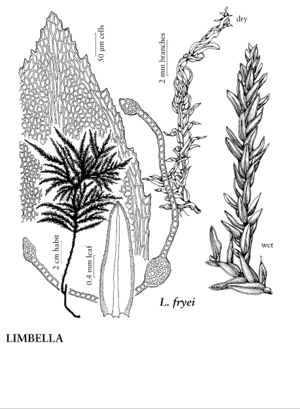Limbella
Bull. Bernice P. Bishop Mus. 40: 23. 1927.
| Taxon | Illustrator ⠉ | |
|---|---|---|
 | Limbella fryei | Patricia M. Eckel |
Plants small to large, yellow-green to blackish. Stems coarse, often dendroid, irregularly branched to subpinnate beyond ± naked stem; hyalodermis absent, central strand present; paraphyllia absent; rhizoids at stem base, densely matted, not forming tomentum, smooth; axillary hair distal cells 4–7, hyaline. Stem-leaves spreading, straight or incurved, ovate-oblong or ovatelanceolate, not plicate, 1.5–3.5 mm; base not decurrent; margins plane, serrulate to serrate, occasionally entire, limbidia conspicuous or poorly developed, usually submarginal, (2–) 4-stratose, cells incrassate; apex acuminate to subulate, or cuspidate; costa single, strong, percurrent to short-excurrent; alar cells undifferentiated; basal laminal cells usually oblong; distal cells subquadrate to rhomboidal, 3–36 × 3–18 µm. Branch leaves similar. Sexual condition dioicous. [Capsule horizontal to cernuous, oblong-cylindric, asymmetric, sometimes arcuate; peristome hypnoid; exostome margins dentate; endostome cilia appendiculate. Spores 14–18 µm].
Distribution
Oreg., Pacific Islands (Hawaii)
Discussion
Species 2 (1 in the flora).
Species of Limbella have been included previously in Sciaromium (Mitten) Mitten, a synonym of Echinodium Juratzka (S. P. Churchill 1986). Limbella tricostata (Sullivant) Brotherus is endemic to Hawaii.
Selected References
None.
Lower Taxa
"narrower" is not a number.